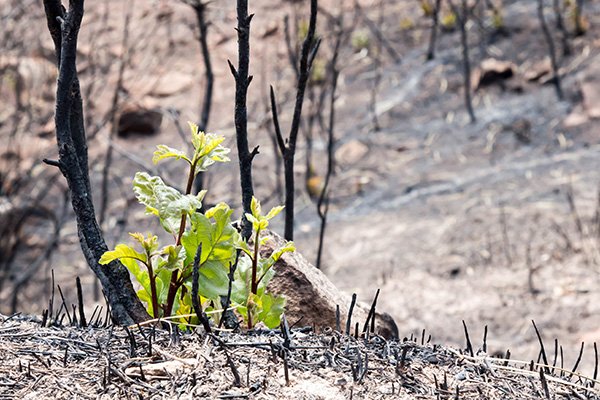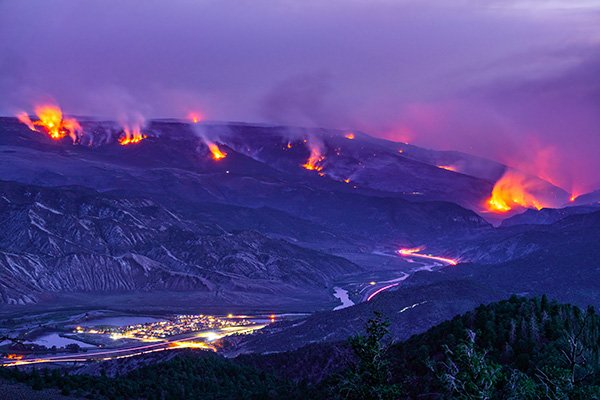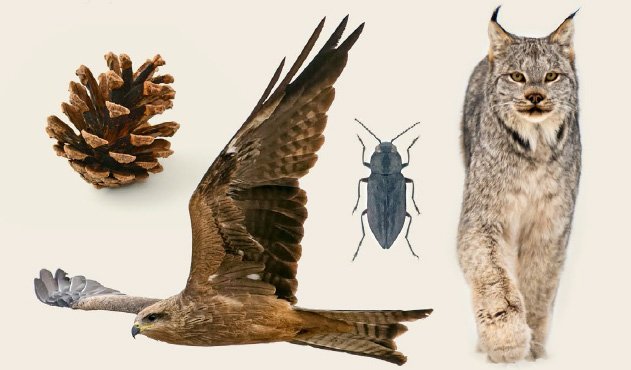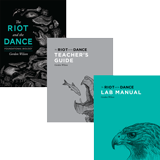Wildfires: Cause for Alarm?
As stewards of creation, sometimes we must work with fire, not against it.
During my college days, I fought forest fires for three summers as a member of the 20-man Highlands Fire Crew. In early June of 1979, I was fresh out of high school when I arrived at Highlands Fire Camp in north central Washington. Out of the frying pan and into the fire . . . quite literally. Our head foreman, Butch, led our crew to battle blazes all summer long. Butch was a quintessential redneck. He sported a can of chewing tobacco in each breast pocket. Beneath his orange hardhat, his hair was sculpted with gel into a hairstyle of a bygone era, and his deep backwoods drawl was lower than Johnny Cash’s.
Though he trained us well, he didn’t think putting out fires was always the best thing. Once when Butch was driving our crew through the mountains, he glanced at a dense stand of trees and announced, “That thar forest needs a good fawr.” Did he want us all to have more overtime? No. He explained to us that when fires are always put out, forests become loaded with too much fuel such as dense trees and undergrowth on top of a thick accumulation of forest litter. He felt that Washington State should let some fires burn to thin out the trees, consume the dense undergrowth, and open up the forest (provided it wouldn’t endanger peoples’ lives). Butch was no ecologist, but he had common sense and enough experience with fires to know that a fire can improve a forest in the long run.

So What Is Wise Dominion?
Forests are ecosystems that host many different kinds of plants and animals. In Genesis 1:28, God commands mankind to have “dominion over the fish of the sea and over the birds of the heavens and over every living thing that moves on the earth.” Since wildfire impacts many creatures and humans, managing it surely qualifies as dominion.
In western North America and Australia, millions of acres burn each year. Certain ecosystems, particularly semi-arid grasslands, sagebrush, chaparral,1 open forests of Ponderosa pine and other conifers in western North America, and eucalyptus woodlands in Australia are prime candidates to go up in flames under the right conditions. If this is more or less normal, why is wildfire considered a problem? Fire destroys human life and stuff that we greatly value such as homes, barns, wild and domestic animals, commercial buildings, vehicles, timber, and recreational areas. So for over a hundred years, the basic well-intentioned plan has been to suppress fires, to put them out.
However, we must keep the big picture in mind. We often see a particular ecosystem like a snapshot at its peak beauty and glory. We don’t see all the factors that contribute to that beauty over time. Fire significantly contributes to the beauty of ecosystems. These ecosystems are adapted for fire and are healthiest when periodic, less-devastating fires sweep through them every couple decades or so. Wise dominion means working with the natural rhythms of these ecosystems.

Blessings of Blazes
If we look at wildfire only as something that mars the beauty of the land, we will view it as only something to combat. But short-term unpleasantness often results in long-term blessing. Smaller, more frequent prescribed fires declutter, refresh, and renew the land. In other words, they prevent the accumulation of massive amounts of dead wood and leaf litter, greatly reducing the threat of devastating megafires.
God has designed his creation so that fires release many nutrients and warm the soil, causing new plant growth. Several conifers have cones that are designed to open only after being scorched. Their seeds fall to the ground where they can germinate. Eucalyptus trees are also adapted to fire. Their seeds are intolerant of shade. When fires burn away the overstory, their seeds readily germinate in the sun and the fresh layer of ash.
Fires also knock down diseased trees and eradicate insect pests. Whereas sickly, weak, and diseased trees often don’t survive trial by fire, healthy trees are more resilient and are more likely to endure, increasing the overall health of the ecosystem.
The smoke attracts many good insects designed to home in on burned areas. People may not like burnt real estate in the short term, but often new plant growth quickly springs up and draws in many birds and smaller mammals looking for a new home. The long-term benefits of smaller fires appear to outweigh the short-term negatives.

From the ashes of a scorched forest, new life emerges like this young scrub oak.
Devastating Damages
Megafires are usually a different story. They can be so devastating that the blessings are often eclipsed by the overwhelming damage. Recovery time is much longer and may require costly human intervention (tree planting and returning rescued animals to their natural habitat) to restore the flora and fauna.
These fires are often ignited due to poorly maintained powerlines, human carelessness, arson, or natural causes like lightning strikes. And once lit, the fires get out of control—fast. In 2020 alone, an area in California larger than the state of Connecticut went up in flames. Australia’s 2019–20 bushfires scorched over 46 million acres. In 1950, the largest megafire in North American history, the Chinchaga fire, consumed between 3.5 and 4.2 million acres in British Columbia and Alberta, Canada.2 And more recently in 2016, the Fort McMurray fire in Alberta torched over 1.4 million acres, causing 88,000 people to be evacuated from their homes.
Often smaller fires merge into catastrophic megafires, killing people, destroying many homes, and causing millions to suffer physically and emotionally due to the oppressive and hazardous smoke blanketing enormous regions. Although good things may result from catastrophic megafires, the negatives far outweigh the positives.

In the summer of 2020, flames of the Grizzly Creek Fire could be seen glowing in the mountains above Glenwood Springs, CO.
Is Climate Change to Blame?
With their green agenda, environmentalists incessantly claim that climate change is the major cause of hotter, drier, and longer summers, resulting in megafires in the US, Canada, and Australia, and hotter, longer dry seasons in the Amazon. We are constantly told that the best way to battle these fires is to fight climate change. But this is not the case.
Even if we assume that climate change is a factor, in both western North America and Australia, climate change is at most a minor factor. A closer look at data of Australian fires has clearly shown that wildfires were at low levels for a couple of decades when prescribed burns were intensely practiced. As policies changed to reduce the size of prescribed burns (due to pressure from environmental groups), wildfires began to increase in size. In short, the major problem is not climate change but rather the accumulation of woody fuel.3 Turns out, Butch was right: fire suppression without periodic prescribed burns results in the accumulation of way too much woody fuel.
The data is similar in California, but with one distinction. California has two basic types of fire: fuel-dominated and wind-dominated. The sparsely populated Sierra fires are examples of the former, whereas the highly populated chaparral fires are examples of the latter and account for the vast majority of California’s most deadly blazes on record. Neither excess fuel nor climate change is a major driving factor in shrubby chaparral fires. Since 2000, most of the fires in chaparral were caused by humans. A much better explanation for these catastrophic conflagrations is the fact that several million people, wanting to flee the concrete and commotion of urban settings, have sprinkled themselves into this scenic yet dry ecosystem in the last few decades.4
Working with Nature, Not against It
It is clear that wildfires are becoming larger, more frequent, and dangerous in semi-arid landscapes for a variety of reasons. Whatever the reasons, whenever dry combustibles are plentiful, wildfires are inevitable. If fire is a normal and essential feature of these types of ecosystems, how do we ensure that these fires don’t become devastating to people and wildlife as they have in both North America and Australia?
We need to humbly admit that only God is ultimately in control of all things: big things, like the weather, climate, and megafires, and small things, like the number of hairs on your head and the sparrows that live or die (Matthew 10:28–30). Acknowledging the comfort of God’s sovereignty doesn’t mean we sit back and twiddle our thumbs. God uses means to accomplish his ends, and the means he gave us is the dominion mandate. God wants us to wisely rule over fire.
Land management at both the public and private levels should consider the ecology of the land and the inherent hazards associated with wildfire. Any society seeking the well-being of its people, plants, and animals should develop a good long-term plan to prevent megafires or minimize damages when fires do occur. We can most certainly lessen the unintentional impacts of fire each year by following a few wise land management practices.
Avoid Fire-Sparking Activities
Those enjoying outdoor recreation in these areas should—when fire warnings are posted—refrain from all activity that involves sparks and flames such as campfires, fireworks, and off-road vehicles such as dirt bikes and ATVs. Those who kindle wildfire by carelessness, arson, or badly maintained powerlines should be held responsible.
Limited Burns
Remove most of the excess fuel by having prescribed, limited burns (this also helps control the amount of hazardous smoke blanketing an area) or by thinning forests (removal of certain trees and excess undergrowth) while at the same time working to maintain the biodiversity in the ecosystem.
Though necessary, the option of initiating a prescribed burn is risky. The dynamics of fire are complex, whether prescribed or wild. The interplay of weather and terrain makes each fire unique and difficult to predict. Even prescribed burns have gotten out of hand and have turned into megafires, displacing many people and destroying many homes. Wind and weather can change suddenly, and even the best laid plans can literally and figuratively go up in smoke. These costly mistakes have made it more necessary for fire managers to go high tech. Because wildfire, though highly complex, still obeys the laws of physics, fire managers are now using computer modeling5 to help predict what a fire may do under a given set of conditions. A model’s output is only as good as its input, which means these systems will always need fine-tuning to make their predictions more accurately reflect the behavior of real fires. Nevertheless, it is a good example of exercising dominion in a tangible way, whether or not these managers are purposely pursuing the dominion mandate of Genesis 1:28.
Understand the Risk and Prepare
People who choose to build in a fire prone area should understand the inherent risks and their responsibility. Is it wise to build and live in an extremely fire prone area? Proverbs 22:3 says, “The prudent sees danger and hides himself, but the simple go on and suffer for it.” Today in California, if Jesus taught the parable of the foolish man who built his house upon the sand, he might say, “The foolish man builds his wooden house in tinder-dry chaparral.”
If homeowners insist on building in these areas, they should at least be encouraged to design, build, landscape, and/or retrofit existing structures to make them far less vulnerable to wildfire. This would include clustering developments in less vulnerable areas, surrounding them with well-watered barriers like orchards and other firebreaks, and installing nonflammable roofing, which will resist catching fire from flying embers. Since fires are inevitable, it is also prudent for communities to have effective warnings and evacuation strategies.
The End of the Matter
Of course, it is good to discover the best fire management plans using science, experience, and ingenuity; however, it is of utmost importance to exercise dominion to the glory of God. When nations attempt to exercise dominion over fire—or anything, for that matter—it is easy for best management practices to fall by the wayside when their governments are pursuing power, businesses are pursuing unreasonable profit, and environmental groups are pursuing the exultation of nature over mankind. Even if a country or state implements effective, healthy ways to manage fire, if God is cast aside and power, profit, or nature become idols, he can still thwart our best efforts.
In Isaiah 45:7, God says, “I form light and create darkness; I make well-being and create calamity; I am the LORD, who does all these things.” Megafires are most certainly calamities from a human perspective, and when we humble ourselves before the Lord, he will bless our efforts and give us wisdom as we attempt to exercise our dominion over the flames.
Designed for the Blaze
We see evidence of the Creator’s design everywhere we look, from the highest mountain to the deepest ocean. God has given creation the ability to adapt and thrive in the harshest of environments, including within wildfire.
Wildfire itself plays an important role in a natural cycle of renewal. But when we look closer through the smoke, we see creatures and plants that actually rely on wildfire to thrive. Here are a few examples of the Creator’s fingerprints amid the flames.

The lodgepole pine, eucalyptus, and banksia trees have cones or fruits sealed shut with resin. Only after a fire’s heat has melted the resin will these cones/fruit release their seeds.
Black kites are attracted to brushfires in Australia where they can swoop down on prey, such as lizards, running from the flames. Some studies suggest that black kites spread fire intentionally by carrying burning twigs and dropping them in the brush, scaring out even more prey.
Fire beetles use infrared receptors on their bodies to detect smoldering trees. These beetles have been known to fly over 50 miles to a blaze and lay their eggs in the damaged trees.
The Canada lynx hunts its favorite prey, snowshoe hares, which live among the low branches of young forests that shoot up following a wildfire.
Answers Magazine
April–June 2021
Footnotes
- Coastal shrubland
- Authorities allowed the Chinchaga fire to burn due to its remoteness and sparse population.
- Myron Ebell, “Australian Wildfires Were Caused by Humans, Not Climate Change,” Competitive Enterprise Institute, January 8, 2020.
- Michael Shellenberger, Apocalypse Never (Harper, 2020), p. 20.
- One example is FIRETEC modeling tool developed by Los Alamos National Laboratory.
Recommended Resources

Answers in Genesis is an apologetics ministry, dedicated to helping Christians defend their faith and proclaim the good news of Jesus Christ.
- Customer Service 800.778.3390
- © 2024 Answers in Genesis







